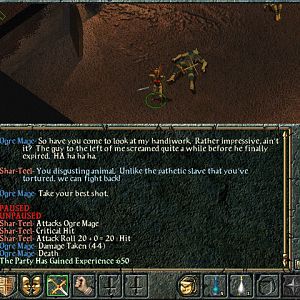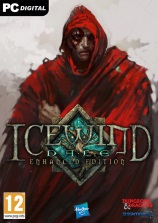-

- Forums
- Chatrooms
- Gallery
- Gameplay Videos
- Upload
- Articles
- Mod Reviews
- Shop SP: Games, Movies, Books

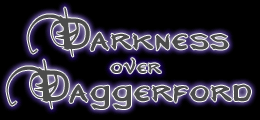 Recently
we've had the chance to talk about the hugely popular Neverwinter
Nights module, Darkness
over Daggerford, with the module's producer and lead designer,
Alan Miranda. Alan is a former BioWare producer, having been the
producer on Baldur's Gate II: Throne of Bhaal and the associate
producer on Neverwinter Nights, and as such, a perfect victim for
the Sorcerer's Place inquisition. The first part of our comfy chair
treatment is available below.
Recently
we've had the chance to talk about the hugely popular Neverwinter
Nights module, Darkness
over Daggerford, with the module's producer and lead designer,
Alan Miranda. Alan is a former BioWare producer, having been the
producer on Baldur's Gate II: Throne of Bhaal and the associate
producer on Neverwinter Nights, and as such, a perfect victim for
the Sorcerer's Place inquisition. The first part of our comfy chair
treatment is available below.
SP: For the introduction, could you tell us the story behind Ossian Studios?
 Alan
Miranda: Our company, Ossian Studios Inc. (www.ossianstudios.com),
was founded three years ago in Vancouver, Canada, by myself (Alan
Miranda) and my partner Elizabeth Starr. After leaving BioWare in
order to return to Vancouver, I felt I had developed enough of a
solid background in producing RPGs that it was feasible to start
a new company in order to develop our own games. Elizabeth is a
very complementary partner for me with her organizational and administrative
skills, so starting a business together came naturally. Both of
us being longtime RPG and adventure gamers, we chose a company name
that would represent the kind of games we wanted to make, which
were epic adventures. Ossian, the legendary Celtic warrior-bard,
fit that theme very well, for who else but a bard could better spin
tales of glory, sorrow, danger, and joy?
Alan
Miranda: Our company, Ossian Studios Inc. (www.ossianstudios.com),
was founded three years ago in Vancouver, Canada, by myself (Alan
Miranda) and my partner Elizabeth Starr. After leaving BioWare in
order to return to Vancouver, I felt I had developed enough of a
solid background in producing RPGs that it was feasible to start
a new company in order to develop our own games. Elizabeth is a
very complementary partner for me with her organizational and administrative
skills, so starting a business together came naturally. Both of
us being longtime RPG and adventure gamers, we chose a company name
that would represent the kind of games we wanted to make, which
were epic adventures. Ossian, the legendary Celtic warrior-bard,
fit that theme very well, for who else but a bard could better spin
tales of glory, sorrow, danger, and joy?
SP: Does Ossian Studios operate in an actual brick-and-mortar building, or are you completely Internet-based, with your employees all working remotely?
Alan Miranda: Well, Elizabeth and I work out of a brick-and-mortar building, but we work with everyone else on the team through the Internet. So we’re essentially a virtual team, with all of our members working out of their homes.
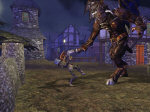 SP:
You probably have a few interesting/amusing tales to tell about
working online with a varied team on such a project over the period
of more than a year...
SP:
You probably have a few interesting/amusing tales to tell about
working online with a varied team on such a project over the period
of more than a year...
Alan Miranda: Working online definitely does have its challenges, and with people located in different parts of the world, there was always some cultural kidding around. But some of the better laughs we had on the project came from game content acting in unpredictable ways. A more memorable one for me is Rab’s Groin Dance, where a gnome in the game who was wearing a tabard from the DLA cloak system couldn’t stop gyrating when you talked with him. Since we didn’t make the cloak system, we couldn’t fix it, and I think it still happens sometimes in Daggerford v1.2.
SP: Please tell us a bit about the development team that has worked on the Darkness over Daggerford module.
Alan Miranda: We had great people on the Daggerford team and we’re proud of all of them. To be honest, everyone did a bit of everything, but I’ll list some of the main things people were responsible for. I was both the producer and lead designer, directing various aspects of the project while doing some hands-on work as well. This included writing the main story and some sidequests, building areas, directing the designers, artists, and music composer, and everyone’s favourite – managing QA and bugs. Elizabeth was the production coordinator, working on text editing for dialogues and descriptions, evaluating in-game content, as well as project planning. Kevin (aka codepoetz) was a rock when it came to the technical aspects in the game, and he developed a lot of our systems, like the cutscene system and scaling encounter system.
Luspr is an excellent character writer, who gets in the mindset of who he is writing, and a lot of the main characters in the game were written by him. Brian Watson (aka MadWombat) was a jack-of-all-trades, and he spent many months getting the world map and random encounter systems working. AlanT (aka Lord Alex) and Anya (aka Lady Oonagh) were the husband and wife team who implemented a number of sidequests and ambient NPCs in and around Daggerford. AlanT’s convos in particular always felt like a torrent of rich dialogue, which was fantastic. And Brian Dunn (aka BrotherRoth) took a lot of care in designing and building all the objects he made for the game, my special favourites being his emblems and signs.
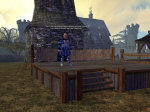 SP:
Alan, you have worked for BioWare for quite a stretch of time. How
did that affect your work on the module in contrast with, let's
say, the work of a typical module builder, who does not have professional
game development experience?
SP:
Alan, you have worked for BioWare for quite a stretch of time. How
did that affect your work on the module in contrast with, let's
say, the work of a typical module builder, who does not have professional
game development experience?
Alan Miranda: Given my professional game development background, I think my expectations for the module were set high from the start. I more or less viewed it as another game that I was making at BioWare, so it had to be of the highest quality. I brought a lot of knowledge to the team about what were good guidelines to follow, based on what I had learned at BioWare. On the flip side though, I had never created a module myself, so there was a lot I learned about the toolset from our team members along the way. They all had very good skills to begin with, but I think the high expectations of the project really encouraged them to step up to a higher level than they had worked at before on their own previous mods.
SP: Did other people from BioWare have a part in the creation of the module, either by means of actual work or contributing ideas?
Alan Miranda: What BioWare contributed was feedback on the initial story proposal that I wrote at the start of the project, and feedback on the game at a couple of points during development. Rob Bartel, in particular, offered some good feedback at the end of February, which helped us recognize the weaker spots in the module. We then came up with solutions which Rob and I agreed upon. When you get very close to your game after working on it for so many months, it’s very useful to get an external perspective. Other than that feedback, and the TNO tilesets given to us by BioWare, Daggerford was developed by Ossian Studios.
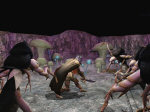 SP:
Please describe your module and its features for those of our readers
who aren't familiar with it.
SP:
Please describe your module and its features for those of our readers
who aren't familiar with it.
Alan Miranda: Darkness over Daggerford is a single-player adventure for level 8 players set in and around the classic D&D setting of the town of Daggerford, along the Sword Coast. The game recreates some of the atmosphere from the Baldur's Gate games with having lots of areas to explore and plenty of sidequests (over 30), most of which are unique and elaborate. We developed a world map system, very similar to the Baldur's Gate one, in order to make travelling between all these areas as easy as possible. A stronghold was also included for players to call home, drop off their loot in, and even decorate. The stronghold also serves as a central location for giving some of the biggest sidequests in the game, which we called stronghold quests, where an array of colourful NPCs would turn up at your door asking for your help (including a talking chicken!). It's defintely a big game and comparable to an expansion, with 25-30 hours of gameplay and almost 200,000 words of dialogue.
SP: The module raises all lower-level characters to level 8 in the beginning. For those of our readers who haven't played the module yet, what kind of a character would you suggest starting with, for the best immersion and harmony with the setting and the plot, or to get the most out of the game?
Alan Miranda: All classes work well in the game, although some players have said they preferred the melee classes. However, we do have two henchmen available, a fighter and a rogue, to help your character should you choose to play as a magic-user or bard.
SP: How challenging is the module for new players? How about the more experienced ones?
 Alan
Miranda: Darkness over Daggerford is not
a high-level module. Its focus is on adventure, stories, and characters,
so to that end it is heavy on role-playing, but should still provide
a decent level of challenge for people in terms of combat. We developed
a special scaleable encounter system called Poetic Justice (PJ for
short) that dynamically accommodates players as they level up during
the game, in order to ensure that enemy creatures always remain
challenging.
Alan
Miranda: Darkness over Daggerford is not
a high-level module. Its focus is on adventure, stories, and characters,
so to that end it is heavy on role-playing, but should still provide
a decent level of challenge for people in terms of combat. We developed
a special scaleable encounter system called Poetic Justice (PJ for
short) that dynamically accommodates players as they level up during
the game, in order to ensure that enemy creatures always remain
challenging.
SP: Darkness over Daggerford has a distinct Baldur's Gate 1 feel, and there's more to it than just the introduction of the world map and free roaming. How did you achieve it? In other words, what was the plan, what was your modus operandi in creating the BG1 feel?
Alan Miranda: That’s somewhat of a tough question to answer. My goal from the start had been to make a game with a BG1 feel, and my approach focused on exploration, which involved having a world map and large, intriguing areas to discover. Each team member then brought their own favourite things from BG to Daggerford. For example, our writers wrote heaps of dialogue for some very colourful characters, which resembled the conversations you had in BG. We also put in a lot of effort into designing very fresh and creative D&D quests, which was also something you saw a lot of in BG1 and BG2. Aside from that, there were never any specific step-by-step plans for imitating BG. It more or less flowed from our knowledge and instinct. Keep in mind that this was Ossian’s first RPG game, as BG1 was BioWare’s, so there’s something magical to be said about the creative electricity (and anxiety) surrounding “first” projects.
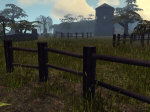 SP:
While the module has a BG1 feel, your work at BioWare had more to
do with Baldur's Gate 2: Throne of Bhaal and Neverwinter Nights.
Would you like to comment on this?
SP:
While the module has a BG1 feel, your work at BioWare had more to
do with Baldur's Gate 2: Throne of Bhaal and Neverwinter Nights.
Would you like to comment on this?
Alan Miranda: The reason I wanted to work at BioWare in the first place was because of all the fun I’d had playing BG1 (I arrived at BioWare around the time that BG2 was being shipped). The original game made a tremendous impression on me and I was extremely interested in creating the same kinds of adventures. My work at BioWare focused on production and leading teams, so I wasn’t involved in the hands-on designing of adventures for ToB or NWN. That’s why when Ossian got the contract to make an RPG for BioWare with a premium module, my thoughts immediately swung back to BG1 and the creative gears of design began cranking away.
SP: If we are already talking about inspirations, maybe you could also identify other factors, other sources of lore which have influenced the module? For example, the Castle Exeltis quest feels a bit Arthurian, if not too far removed from the paladinic thread in BG2?
Alan Miranda: I’ve actually never played the paladin quests in BG2, although I did draw some inspiration from the De’Arnise Keep quest with infiltrating the castle and lowering the drawbridge, when writing the Princess of Fanloc quest. Including the return of a talking chicken from BG1 was also too good to pass up. Other things that have influenced the team have come from the love of history, tabletop D&D, medieval warfare, Celtic mythology, and from comedies like Black Adder and Monty Python. Listening to a little Wagner also helped a couple of us. :)

